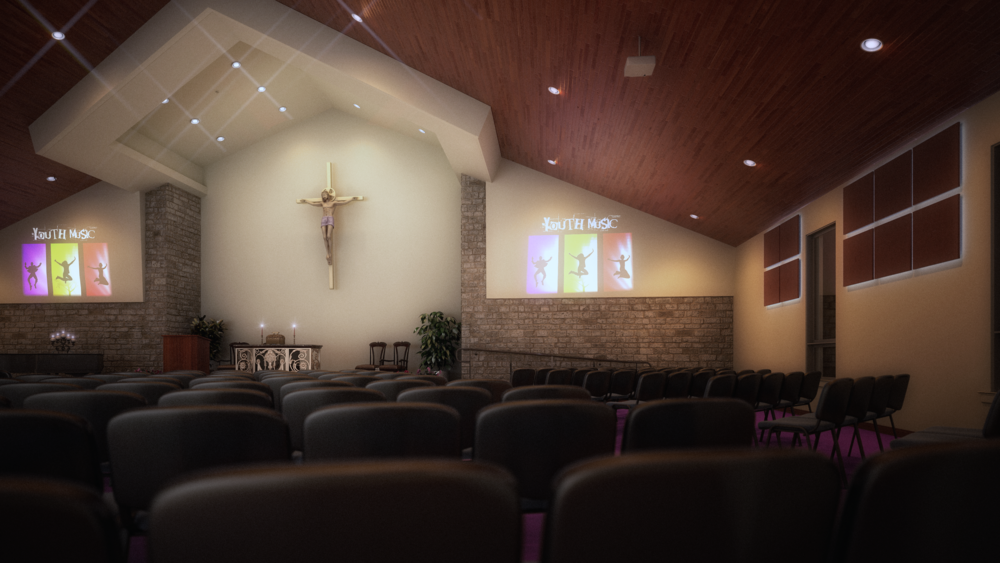“No great work is ever done in a hurry. …to do anything great requires time, patience, and perseverance.”
W. J. Wilmont Buxton
Church Worship Center
Here, is a Church Worship Center, that I had the pleasure to work on, and I would like to share it with you. If you have any questions, please leave a comment.
Center of Interest
The first and most important aspect of your 3D rendering is the focal point or center of interest, the one spot in your 3D rendering where your eye ultimately ends up.
Once you decide what your center of interest is and where you want to place it, you can begin adding all of the other elements of composition that help your eye flow through the 3D rendering The goal in any rendering is to lead the eye to your center of interest.
It takes a lot of thought and careful planning to make all the elements of composition successful.
Importance of Lighting
Whether lighting is harsh, gentle, glaring, or diffused; whether it is cold; whether it comes straight at us like a spotlight or from the side, behind, above, or below - it plays perhaps the greatest role in determining the mood of a 3D rendering.
All light - whether it's frontlight, sidelight, backlight, or diffused light - imparts a color cast onto the subject, depending on the time of day. Morning light is warmer than midday light, and late afternoon light (shortly before sunset) is even warmer still, wheres diffused light can at times be "blue".
What is meant by frontlight?
It's light that hits the front of your subject, as if your camera were a giant spotlight bathing everything in front of it in light.
Sidelight hits one side of a subject, illuminating only part of it leaving the other parts in "darkness". The subject takes on a three-dimensional quality due to the illusion of depth created by the contrast between light and dark. As a result, sidelight is often considered the most dramatic type of lighting.
It is backlighting (when the light hits the back of your subject) that renders so many subjects in silhouettes. Backlighting will always find you reaching for your sunglasses or, at least, shading your eyes. Why? Because to render backlight, you must be facing the sun itself.
Unlike sidelight, which conceals the subject in partial darkness, backlighitng can cloak the entire subject in total darkness. The resulting silhouetted shape - whether it's a tree, your building, or a person - is devoid of all detail.
If you have any question please, contact me, and I'll reply as soon as possible.
Sky Composition
Your skies will always profit from some preparation beforehand. In most renderings, the sky should enhance the building features without trying to dominate, and help to highlight the center of interest, particularly in those features that extend up into the sky, such as the tall buildings, trees, and so on.
The positioning of elements such as large cloud masses, the brightest part of the sky, or the most colorful, can considerably influence the overall composition of the rendering. On the other hand, you may wish to play down an area, most commonly the utmost point of the rendering.
In the above image, where is your eye drawn? because of the sky composition, your eye is drawn to the bottom, left 3rd, of the photo.
If you have any question please, contact me, and I'll reply as soon as possible.
Atmosphere - Pink Mud
Mood or atmosphere is the icing on the rendering cake. When used with thought, it can completely transform a scene and can inject a sense of power and drama at the same time. You can use atmosphere to enhance a "normal" rendering into one conveying power and beauty of nature's finest moods. We can use it to lose unwanted detail, or suggest mystery, impending doom, a light, airy afternoon, tranquil moments, and much more.
Mood can be especially effective in highlighting a center of interest or suggesting a narrative. Try to get out of the habit of always rendering fields green, clouds white, or mud brown - flood the whole composition with a color mood to suit your idea, even if it conflicts with color we normally assume to be correct. Those who fail to see pink mud are truly restricting their imaginative palette.
atmosphere and mood
If you have any question please, contact me, and I'll reply as soon as possible.
Creating a Tranquil Mood
While wind, storms, and dramatic scenes rely on diagonals and vertical emphasis, to convey a sense of peace and tranquility, you need the emphasis to be on a more horizontal composition.
A Tranquil Mood
If you have any question please, contact me, and I'll reply as soon as possible.










